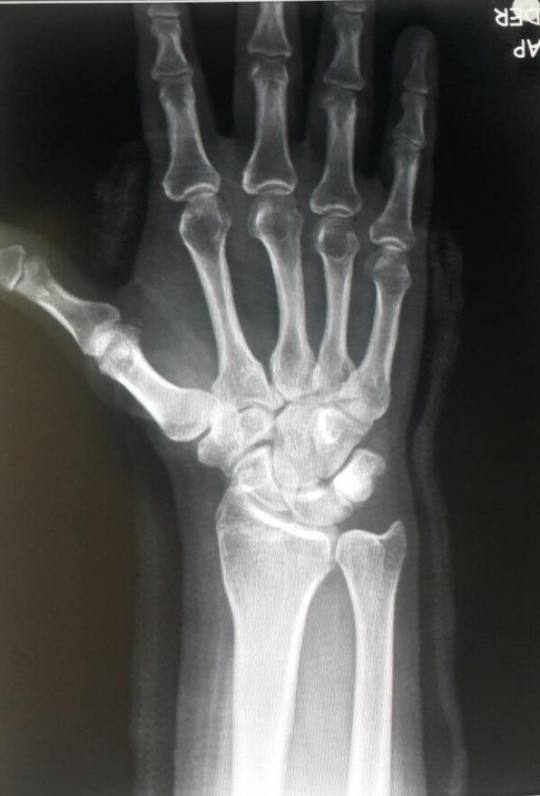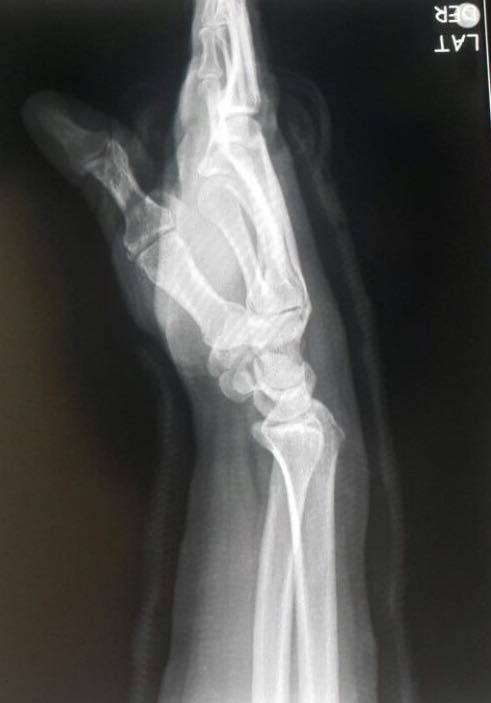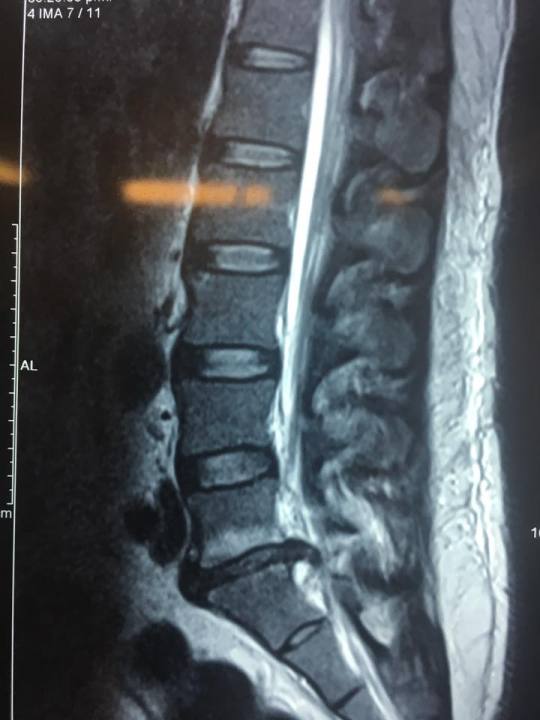| |||||||||||||||
|
jueves, 23 de marzo de 2017
Anestesia en cirugía urológica / Anesthesia for urology
Manejo conservador de fractura articular no desplazada de apófisis estiloides radio distal
Manejo conservador de fractura articular no desplazada de apófisis estiloides radio distal con Delta Dry y delta soft cast (fibra de vidrio que se puede mojar y muy ligera) excelente resultado, no todo es cirugía!! 8 semanas de evolución listo para retiro y envío a fisioterapia


Un marco para la etiología de las lesiones relacionadas con el running (correr)
A framework for the etiology of running-related injuries
Fuente
Este artículo es originalmente publicado en:
De:
2017 Mar 22. doi: 10.1111/sms.12883. [Epub ahead of print]
Todos los derechos reservados para:
This article is protected by copyright. All rights reserved.Copyright © 1999 – 2017
All Rights Reserved
Abstract
The etiology of running-related injury is important to consider as the effectiveness of a given running-related injury prevention intervention is dependent on whether etiologic factors are readily modifiable and consistent with a biologically plausible causal mechanism. Therefore, the purpose of the present article was to present an evidence-informed conceptual framework outlining the multifactorial nature of running-related injury etiology. In the framework, four mutually exclusive parts are presented: (A) Structure-specific capacity when entering a running session; (B) Structure-specific cumulative load per running session; © Reduction in the structure-specific capacity during a running session; and, (D) Exceeding the structure-specific capacity. The framework can then be used to inform the design of future running-related injury prevention studies, including the formation of research questions and hypotheses, as well as the monitoring of participation-related and non-participation-related exposures. In addition, future research applications should focus on addressing how changes in one or more exposures influence the risk of running-related injury. This necessitates the investigation of how different factors affect the structure-specific load and/or the load capacity, and the dose-response relationship between running participation and injury risk. Ultimately, this direction allows researchers to move beyond traditional risk factor identification to produce research findings that are not only reliably reported in terms of the observed cause-effect association, but also translatable in practice. This article is protected by copyright. All rights reserved.
Resumen
Es importante tener en cuenta la etiología de la lesión relacionada con el running, ya que la eficacia de una intervención de prevención de lesiones relacionada con el running depende de si los factores etiológicos son fácilmente modificables y consistentes con un mecanismo causal biológicamente plausible. Por lo tanto, el propósito del presente artículo fue presentar un marco conceptual fundamentado en evidencia que describa la naturaleza multifactorial de la etiología de las lesiones relacionadas con el running. En el marco, se presentan cuatro partes mutuamente exclusivas: (A) Capacidad específica de la estructura al entrar en una sesión de running; (B) Carga acumulada específica de la estructura por sesión de running; © Reducción de la capacidad específica de la estructura durante una sesión de running; Y, (D) Exceder la capacidad específica de la estructura. El marco puede entonces ser utilizado para informar el diseño de futuros estudios de prevención de lesiones relacionadas con el running, incluyendo la formación de preguntas e hipótesis de investigación, así como el monitoreo de exposiciones relacionadas con la participación y no relacionadas con la participación. Además, las futuras aplicaciones de la investigación deben centrarse en cómo abordar cómo los cambios en una o más exposiciones influyen en el riesgo de lesiones relacionadas con el running. Esto requiere la investigación de cómo diferentes factores afectan la carga específica de la estructura y / o la capacidad de carga, y la relación dosis-respuesta entre la participación en el runningy el riesgo de lesión. En última instancia, esta dirección permite a los investigadores ir más allá de la identificación tradicional de factores de riesgo para producir hallazgos de investigación que no sólo se reportan de manera fiable en términos de la relación causa-efecto observada, sino que también se pueden traducir en la práctica. Este artículo está protegido por derechos de autor. Todos los derechos reservados.
Es importante tener en cuenta la etiología de la lesión relacionada con el running, ya que la eficacia de una intervención de prevención de lesiones relacionada con el running depende de si los factores etiológicos son fácilmente modificables y consistentes con un mecanismo causal biológicamente plausible. Por lo tanto, el propósito del presente artículo fue presentar un marco conceptual fundamentado en evidencia que describa la naturaleza multifactorial de la etiología de las lesiones relacionadas con el running. En el marco, se presentan cuatro partes mutuamente exclusivas: (A) Capacidad específica de la estructura al entrar en una sesión de running; (B) Carga acumulada específica de la estructura por sesión de running; © Reducción de la capacidad específica de la estructura durante una sesión de running; Y, (D) Exceder la capacidad específica de la estructura. El marco puede entonces ser utilizado para informar el diseño de futuros estudios de prevención de lesiones relacionadas con el running, incluyendo la formación de preguntas e hipótesis de investigación, así como el monitoreo de exposiciones relacionadas con la participación y no relacionadas con la participación. Además, las futuras aplicaciones de la investigación deben centrarse en cómo abordar cómo los cambios en una o más exposiciones influyen en el riesgo de lesiones relacionadas con el running. Esto requiere la investigación de cómo diferentes factores afectan la carga específica de la estructura y / o la capacidad de carga, y la relación dosis-respuesta entre la participación en el runningy el riesgo de lesión. En última instancia, esta dirección permite a los investigadores ir más allá de la identificación tradicional de factores de riesgo para producir hallazgos de investigación que no sólo se reportan de manera fiable en términos de la relación causa-efecto observada, sino que también se pueden traducir en la práctica. Este artículo está protegido por derechos de autor. Todos los derechos reservados.
lunes, 20 de marzo de 2017
Reconstrucción anatómica de la cabeza humeral con aloinjerto de talus osteocondral fresco para inestabilidad glenohumeral recurrente con lesión de Hill-Sachs inversa
Anatomic Humeral Head Reconstruction With Fresh Osteochondral Talus Allograft for Recurrent Glenohumeral Instability With Reverse Hill-Sachs Lesion
Fuente
Este artículo es originalmente publicado en:
Este artículo es originalmente publicado en:
http://www.arthroscopytechniques.org/article/S2212-6287%2816%2930199-2/fulltext#.WLz5SmvuKgo.twitter
De:
George Sanchez, B.S., Katrina Schantz, P.A.-C., Marcio Ferrari, M.D., Anthony Sanchez, B.S.,
Salvatore Frangiamore, M.D., Sandeep Mannava, M.D., Ph.D.
Artículo en PRENSA
Todos los derechos reservados para:
© 2016 by the Arthroscopy Association of North America
The treatment of recurrent glenohumeral instability, especially with a concomitant bony lesion, remains challenging. This is especially true in the case of posterior instability given its less common incidence. Moreover, the presence of an engaging reverse Hill-Sachs lesion in combination with posterior instability will result in the need for a more aggressive treatment option. In comparison with a Hill-Sachs lesion, a reverse Hill-Sachs lesion features greater chondral deficiency that must be addressed during treatment. We propose the talus allograft as a potential allograft for treatment of an engaging reverse Hill-Sachs lesion. The superior articular surface of the talus may be used to reconstruct the articular surface of the humeral head. In this technical note, we describe our preferred primary technique for treatment of an engaging reverse Hill-Sachs lesion with recurrent glenohumeral instability through use of a fresh osteochondral talus allograft, as well as discuss the advantages and disadvantages of this allograft option.
El tratamiento de la inestabilidad glenohumeral recurrente, especialmente con una lesión ósea concomitante, sigue siendo un reto. Esto es especialmente cierto en el caso de la inestabilidad posterior dada su incidencia menos común. Además, la presencia de una lesión inversa Hill-Sachs inversa en combinación con la inestabilidad posterior resultará en la necesidad de una opción de tratamiento más agresiva. En comparación con una lesión de Hill-Sachs, una lesión inversa de Hill-Sachs presenta una mayor deficiencia de condral que debe ser abordada durante el tratamiento. Proponemos el aloinjerto del astrágalo como un posible aloinjerto para el tratamiento de una lesión de Hill-Sachs inversa. La superficie articular superior del astrágalo se puede utilizar para reconstruir la superficie articular de la cabeza humeral. En esta nota técnica describimos nuestra técnica primaria preferida para el tratamiento de una lesión inversa de Hill-Sachs inversa con inestabilidad glenohumeral recurrente mediante el uso de un aloinjerto de talud osteocondral fresco, así como discutir las ventajas y desventajas de esta opción de aloinjerto.
Enviar por correo electrónicoEscribe un blogCompartir en XCompartir con FacebookCompartir en Pinterest
Etiquetas:
aloinjerto,
Anatomic Humeral Head Reconstruction,
cabeza humeral,
Glenohumeral Instability,
Hill-Sachs Lesion,
Osteochondral Talus Allograft,
Reconstrucción anatómica,
talus osteocondral
Suscribirse a:
Entradas (Atom)



